The World Gold Council (WGC) predicts that gold investment demand in China will continue to rise this year, though at a slower pace compared to 2024. Last year, China saw strong growth in gold investment, driven by increased purchases of gold coins and bars.
Several factors are expected to support this growth, including poor performance in other assets like stocks, high returns from gold investments in 2024, declining interest rates, and ongoing gold purchases by China’s central bank. These factors have boosted investor confidence in gold as a safe-haven asset.
Wang Lixin, Regional CEO of WGC (China), stated, “Domestic interest rates may fall more than expected, and the renminbi could face fluctuations. These conditions are likely to increase demand for gold investment in China.”
Wang explained that the renminbi might come under pressure due to the widening gap between Chinese and U.S. interest rates. This is partly because the U.S. Federal Reserve is unlikely to cut rates further, and there could be higher U.S. trade tariffs. In such a scenario, investors are expected to turn to gold to hedge against risks.
He added, “If China’s central bank continues to buy gold this year, investor interest in gold could grow even more. However, if other assets like stocks perform better, gold demand might decrease.”
Rising gold prices could also encourage more investors to buy gold. Sharon Ding, Head of China Basic Materials at UBS, predicted that gold prices could reach $3,000 per ounce by 2025. This is due to expected rate cuts by the U.S. Federal Reserve and other major central banks, as well as ongoing geopolitical risks.
In 2024, gold prices in China hit record highs, with renminbi-denominated gold prices rising by 28%. This led to a surge in gold investment demand. Demand for gold coins and bars reached 336 metric tons, up 20% from 2023, marking the highest level since 2013.
Gold exchange-traded funds (ETFs) also saw strong growth, with total inflows reaching 31 billion yuan ($4.24 billion). By the end of 2024, total assets under management in Chinese gold ETFs hit 71 billion yuan, a 150% increase from the previous year, setting a new record.
Wang noted, “Volatility in bond and stock markets last year pushed more investors toward gold. Fluctuations in the renminbi exchange rate also increased demand for gold as a hedge. The central bank’s gold purchases further boosted investor sentiment.”
However, high gold prices have impacted demand for gold jewelry. In 2024, gold jewelry demand in China fell by 24% to 479 metric tons. Despite this, the total value of gold jewelry purchased only dropped by 7% to 261.5 billion yuan, the third-highest level on record.
Deng Ronghua, General Manager of Chow Tai King Jewelry, said the company is focusing on customers in smaller cities. This year, they opened 150 new stores, with 30 managed by first-time entrants to the industry.
Luxury gold products have shown resilience despite high prices. A report by China International Capital Corp Ltd (CICC) noted that while mainstream jewelry sales were affected by rising gold prices, high-end gold products performed well. For example, Laopu Gold Co Ltd’s revenue is estimated to have surged by 136% to 7.5 billion yuan in 2024, with net profit up 187% to 1.2 billion yuan.
However, major jewelry retailers have felt the impact of high gold prices. Chow Tai Fook reported a 44.4% drop in net profit to HK2.53billion(324.72 million) in its interim results, with a reduction of 239 retail outlets. Similarly, Chow Sang Sang, Lukfook Jewellery, and Lao Feng Xiang also saw profit declines.
In summary, while gold investment demand in China is expected to grow, high prices have created challenges for the jewelry sector, particularly for mainstream retailers.
Related topic:
- Bernhard H. Mayer Unveils Timeless Valentine’s Day Collection through QNET
- Louis Vuitton’s Valentine’s Day Fine Jewelry Collection
- China’s Jewelry Market Faces Challenges as Diamond Demand Declines


